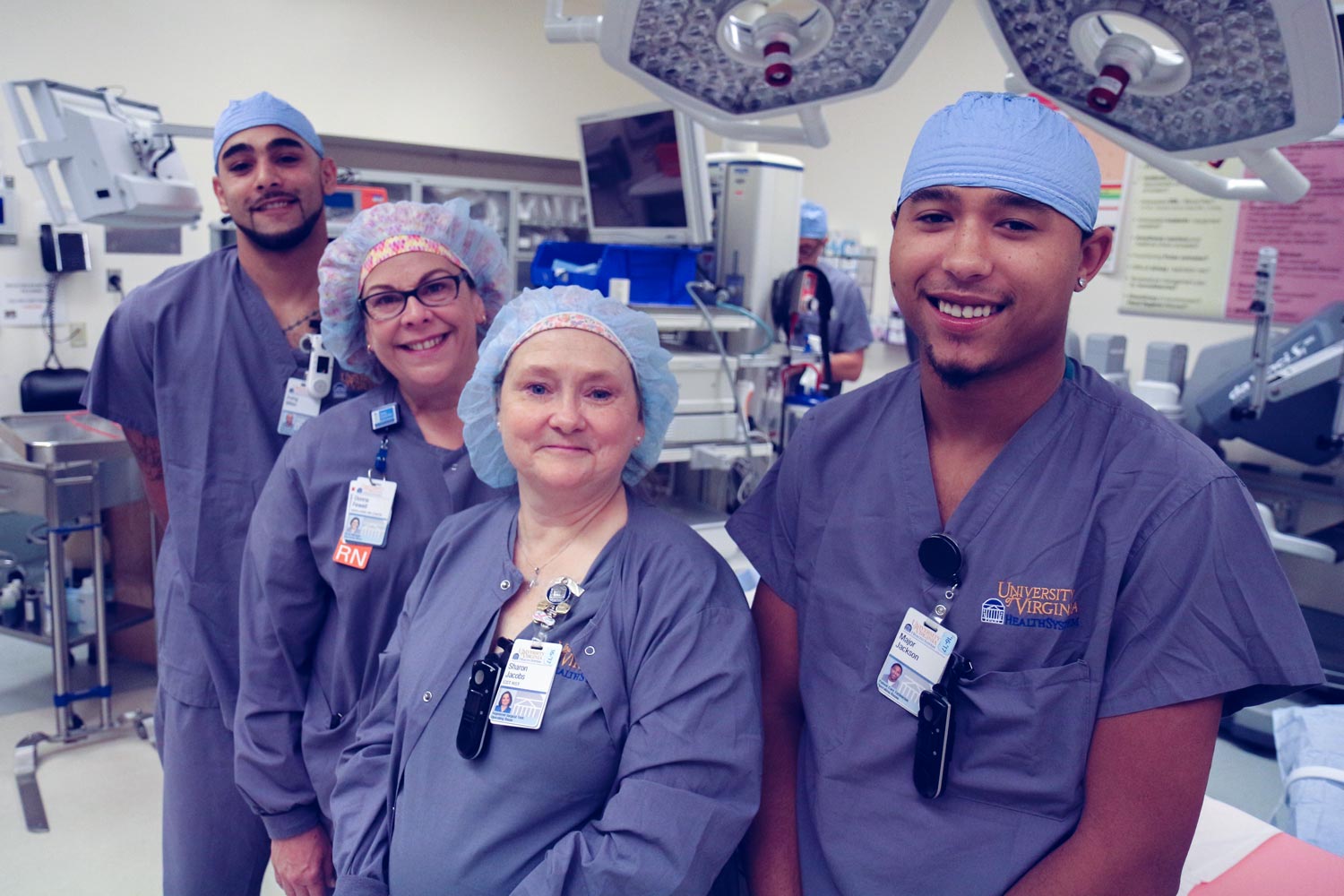What happens in the University of Virginia Medical Center’s 29 busy general operating rooms is profoundly critical in the fight to save, improve and prolong patients’ lives.
But what happens in the OR between patients, as teams of specialists clean up and prepare the space for who and what’s to come next, is just as important, if less heralded.
While some come and go, like patient transporters who wheel patients into recovery areas, and sterile processing technicians who remove used surgical instruments for sterilization, others work on the room itself: emptying accumulated trash, stripping soiled bed linens, sweeping and mopping floors, and painstakingly wiping every single surface – lights, shelves, walls – to ensure sterility.
It was 2016 when the OR team determined to overhaul these processes. Jobs were consistently getting done, and well, but the timeliness of room turnover was occasionally spotty and needed improving.
Enter Crockett Stanley, John Owen and Donna Fewell, a process improvement coach, a nursing professor and a UVA nurse manager, respectively. The trio assembled a team of stakeholders, conducted data analysis and plotted a path forward. The idea, they asserted, was not to issue mandates to change, but to work interprofessionally across disciplines to improve systems through collaboration.
First, they assessed room turnover metrics. Between January and June 2016, it took an average of 61 minutes for scrub and anesthesia technicians, patient care technicians and circulating nurses to clean up from one surgery and prepare for the next.
“We were surprised,” said Fewell, a veteran operating room nurse. “That seemed like a long time. We realized that everybody did something different, and did it as a team, but room-to-room, there was little consistency. I’d certainly known there was variation, but not to the degree it was happening.”
Led by Stanley, Owen, and Fewell, a larger review team – comprised of a phalanx of nurses, administrators, physicians, anesthesiologists and patient care techs, all of whom had a hand in room turnover – discussed what they did well and areas they perceived were ripe for improvement. The group’s stated goal? Reduce turnover time, “wheels out to wheels in,” by 15 percent.
“We’re not robots, yet processes needed to be more predictable,” Stanley said. “There is definitely standard work and roles in a room turn, and we wanted to take the variation out of it. What we did was work through those processes like we were doing an experiment, testing as we went.”
After reviewing the literature on room-turn procedures and making a list of suggested procedural improvements, Owen established a simulation process for the room-turnover team to practice their new roles and how they did them. He filmed the staff executing their new roles, led subsequent debriefing and assisted the team in ironing out improvements and unforeseen issues. Through these dress rehearsals, a new and better, more streamlined room-turn protocol emerged.
“Simulation is an effective assessment tool,” said Owen, associate director of the Center for ASPIRE, which offers interprofessional programs for nursing and medical students and practicing faculty and clinicians. “It allows you to test proposed changes and make improvements prior to actual implementation.”
Some of the biggest changes involved which staff did what jobs. The circulating nurse, for instance, initially had the most responsibility in a room turn, but the group determined that it was more prudent for patient care techs to assume more responsibility so that the nurse could focus purely on the patient. Other issues, like the time it takes newly mopped floors to dry –10 full minutes, so that the full effect of the antibacterial solution can activate – had to be worked around.

After a six-month process of review, rehearsal and refinement, the team kept data on their new between-surgery moves. Today, their average room turn rate is 34 minutes, a near 50 percent reduction in time.
The improvements go a step beyond efficiency, Stanley said. While the changes yield predictability and punctuality for patients and surgeons, the process will likely also improve staff morale and reduce attrition. If you turn a room efficiently, Fewell explained, you have a more predictable day as well as the specific knowledge of exactly what’s expected of you in your work.
“People know more clearly what their job duties and expectations are,” Fewell said. “Keeping the day predictable and orderly means that you’ve got a good likelihood of getting off at your scheduled time, and that’s a satisfier. It’s one less variable that’s going to impact your personal and family time.”
The overhaul has also provided a road map for others. The general operating rooms’ new procedures are now being moved to other areas, including pediatric, orthopedic and heart and vascular operating rooms. Stanley and others say the task now, in addition to spreading their gospel of efficiency, is to keep the improvements sustained.
“It’s hard work, but it’s not as hard as keeping the momentum sustained,” Stanley said. “But the key is having end-users involved. It was the people who do the work who were most intimately involved, and their ideas and recommendations were taken to heart. That’s a satisfier, too.”
Media Contact
Article Information
November 3, 2017
/content/space-between-med-centers-push-tweak-transitions-between-or-patients

